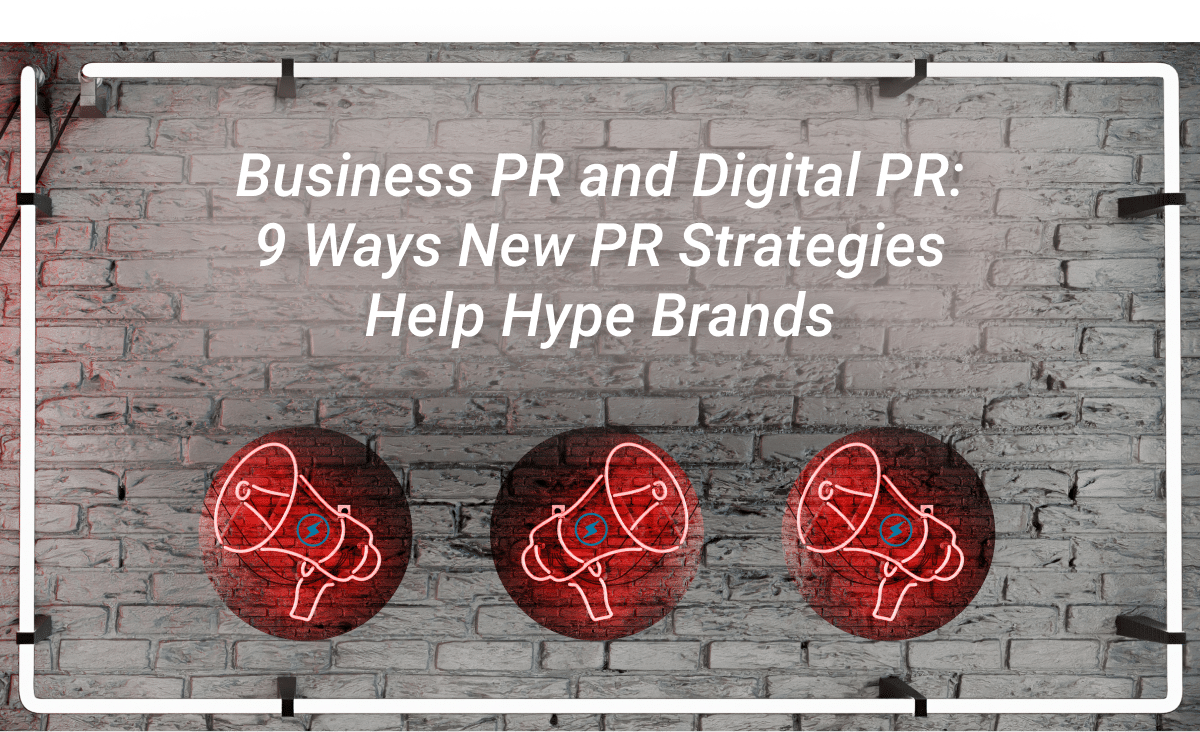
Brand story, differentiation, and positioning are all important parts of building a business, but there is one thing that binds all of these together: effective communication. If you don’t communicate and message your brand to the outside world, all the work you do in the shadows won’t get noticed.
That’s where a good business PR strategy comes into play and, especially in today’s fast-paced world, a good digital PR strategy. With all the tools that exist online, businesses can start communicating their messaging and stories effectively right away, on the cheap, and start building profitability and authority in their niche.
In this post, we’ll talk a bit about traditional business PR, how digital PR improves on its approaches, and some of the modern tools and tactics businesses can use to hype their brand.
Let’s get started.
Why business PR is important
First, why is PR important in the first place, and what we can expect from a good public relations campaign? One of the most important reasons for good PR is that a good public image adds to company market value.
A good public image adds to market value
Executives around the world say about 63% of their company’s market value comes from reputation. In other words, reputation builds profitability, and how do you build on reputation? You form good relationships through positive brand communication.
That’s exactly where PR comes in. PR does the necessary work of communicating your brand features and distinctions through stories in the public space that your target audience can resonate with.
When it comes to reputation in his business, David McHugh, CMO of My Mixify, says it’s everything. “We believe that reputation drives profitability for our company and keeps us sustained so we can move forward toward long-term growth.”
Building relationships helps build more relationships
We can build all kinds of relationships in business, whether it be with the public, the government, our community, or journalists, but what we really are trying to get to with PR is our core target audience and markets. Focusing on target customers is what is going to make our PR campaigns profitable.
We can indirectly get to this audience through intermediaries like journalists, running strategic events, or even through serving our communities. We can also directly interact with our target audience through many digital means, such as email, social media, and SMS.
One thing that PR does is it compounds relationships. When business owners work hard to communicate value to their target customers these strong relationships payoff by others recommending their brand to friends, family, and co-workers.
“Creating long-lasting relationships with our customers builds our business more than any other factor.” says Nolah Mattress CMO and Co-Owner, Stephen Light, “Do not underestimate the power of word of mouth, especially online.”
Difference between traditional PR, marketing, and advertising
Generally traditional business PR is focused on communicating brands’ stories and interactions with the public in a positive way. Marketing is focused on selling products. Advertising traditionally is thought of as paid media spots. But digital PR tends to blur the lines of these categories much more than traditional PR.
“Digital tools have disrupted the traditional communication landscape and have allowed businesses to get the word out much faster than ever before,” says John Buchanan, CEO of Charm Offensive. “The problem is there is so much noise. That’s why we use every medium available to break through this noise and get our message to our target customers. In this case, more is always better. “
Traditional PR vs digital PR
Traditional PR mainly focuses on the news
Traditionally the best way for public relations professionals to communicate their clients’ stories was by pitching a news story in publications or holding an event that they would then publicize. Before the internet, news sites used to own the information highway. PRs would build beneficial relationships with journalists in order to inject their stories into ongoing news coverage. Business PR professionals still do this today through capitalizing on their relationships with journalists and utilizing press releases and MAT releases.
Digital PR focuses on a broader communications strategy
In the video below, Dennis Yu, founder of Content Factory, talks specifically about how personal branding helps build things like high authority SEO. Personal branding is a combination of marketing and PR using digital tools to form a strong relationship with customers. Dennis starts talking about this around the 13 minute mark and discusses how his strong personal branding has ranked him and his brand for terms that he’s never even competed for.
According to Dennis, personal branding is not what you say about yourself, but what others say about you. This is the fundamental goal of a good PR strategy. When others who have authority in their fields reference you as someone who has authority, the necessary results online are authoritative signaling to search engines.
“When it comes to SEO strategy, digital PR is a necessary part of building trust and authority online and should not be discounted,” says louder.online Managing Director, Aaron Agius. “So many SEOs focus on technical tricks to rank. While some of that is important, we’ve found building a strong brand through digital PR campaigns helps our clients rank for topics relevant to them by bringing in traffic, leveraging authority, and building links.”
While Digital PR can also focus on communicating brand messages through news sites and online publications, Dennis’s approach shows how communicators are using a multi-functional approach to digital PR. Digital models of PR tend to merge PR with advertising and marketing.
This approach is sometimes called PESO, a term that originated in the book Spin Sucks by Gini Dietrich. PESO stands for paid, earned, shared, and owned.
This image from Spin Sucks shows how that model is broken down:
There’s a lot to unpack in this image. We’ll do some of that unpacking in the next post. But right now the main thing is to focus on the center. Remember it’s reputation that builds market value and no more is this apparent than on the internet. That’s why PESO works. It uses digital marketing tools to build brand reputation and present a positive image to target customers.
9 ways digital PR helps in building a brand
When businesses start using a model like PESO to communicate, they find that digital PR solves so many problems that traditional PR just can’t. Here are nine things Digital PR can do to help build a brand better than traditional business PR:
- Digital PR takes messages directly to the public that businesses want to communicate with (not needing to use intermediate news sources)
- Digital PR can reach out to journalists on comments with breaking stories without necessarily requiring long-standing relationships. For example, PRs can target HARO or even journalists directly through ads and social media.
- Through effective content marketing, digital PR multi-tasks: simultaneously bringing in referral traffic and building authority. It also allows for the repurposing of content and encourages social shares.
- Digital PR replaces ineffectual, barely read press releases with uber-creative campaigns: leveraging the meme-world, infographics, and all kinds of creative content to communicate with the public and bait links
- It’s also reactive: using automation and other social listening tools, digital PR finds trends and then creates brand strategies around those trends.
- It’s measured more effectively. Using all kinds of analytics tools available today, Digital PRs can track and understand the profitability and impact of campaigns rather than just making educated guesses.
- Like marketers, digital PR can also use ads to retarget potential customers, sending out personalized content to promote their brand.
- As mentioned above, digital PR also builds links. In SEO, Links are a fundamental relationship that connects one brand with another. Links help build the authority of web properties.
- As Dennis Yu notes in the above video, the most important communication strategies are the ones that drive traffic and bring results through increased ROI. Due to the inexpensive nature of digital technologies, there is no better way to communicate than online through paid, earned, shared, and owned methods.
“What we’ve got here is a failure to communicate”
The underlying problem that makes digital PR essential and overcomes many traditional PRs inadequacies is the difficulty of getting a message out in today’s noisy world.
Put marketing, advertising, and social, together with PR, and the din gets louder and louder every day. PRs competitors aren’t just competing with other PRs trying to get their stories out but a whole slew of communicators trying to get the ear of the public.
But, even the PR world is noisy. In 2014, PRs outnumbered journalists by a ratio of 4:1. Though the majority of journalists still use pitches for their articles, according to a recent state of journalism study by Muckrack, they receive anywhere from 5-25 pitches each week, and only a quarter of their stories come from these pitches. Because of this noise, PRs need new tools to get their message out there.
That same Muckrack study found that over 60% of journalists either agreed or strongly agreed that companies aren’t using the most up-to-date methods of sharing information with them.
According to Google’s John Mueller, this focus on digital PR is an important step for businesses and is on level with technical SEO when it comes to building a legitimate brand on the internet.

The other great thing about digital PR is, if done right, through all the means that PESO lays out, brands can rise above spammy link-building practices. They can both give value to those they’re trying to earn business from and gain links. And these links can truly mean what search engines like Google want them to mean: that the brand is an expert, authoritative brand, relevant to the subject at hand, one worthy to rise in the SERPs and serve the searcher’s intent better than any of their competition.
